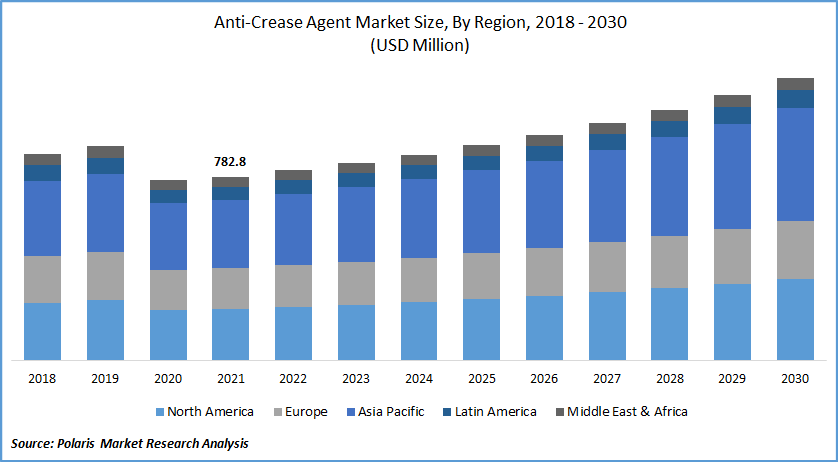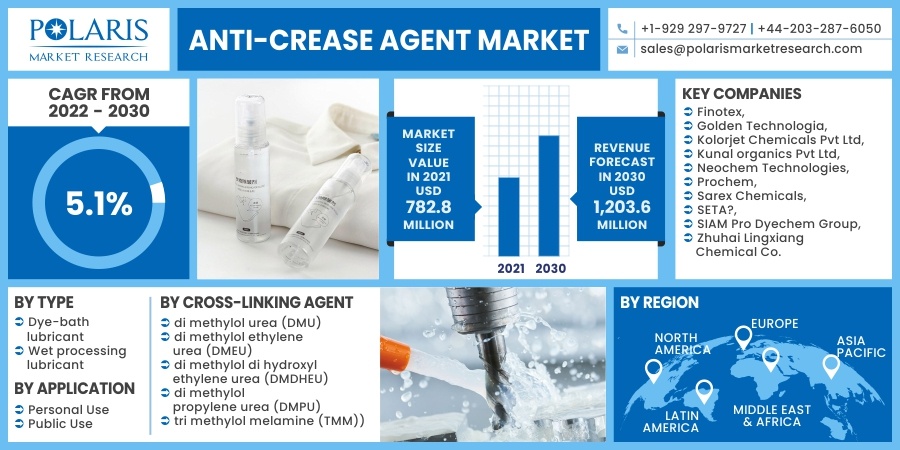
Anti-Crease Agent Market Share, Size, Trends, Industry Analysis Report, By Type (Dye-bath Lubricant, Wet processing Lubricant), By Application (Personal Use, Public Use), By Cross-linking Chemical Agent; By Region; Segment Forecast, 2022 - 2030
- Published Date:Mar-2022
- Pages: 115
- Format: PDF
- Report ID: PM2333
- Base Year: 2021
- Historical Data: 2018 - 2020
Report Outlook
The global anti-crease agent market was valued at USD 782.8 million in 2021 and is expected to grow at a CAGR of 5.1% during the forecast period. Anti-Crease agents are chemicals used for the improvement of appearance & performance of finished textiles. Nowadays, various natural or synthetic resins are utilized in order to impart crease resistance to the finished textiles.

Know more about this report: request for sample pages
With the development of high torque dyeing equipment and high turbulence, there has been an increase in awareness toward the adoption of lubricants in textile wet processing. Lubricants are generally used in order to prevent crease marks & chaffing of knitted goods at the time of processing.
However, creases are inevitable as the overflow machine transports the fabric in rope form. Thus, anti-crease lubricants are used to influence fiber to metal and fiber to fiber friction, reducing the creasing & abrasion faults caused due to friction. Furthermore, the increasing demand for anti-crease agents from the global textile industry is anticipated to surge the anti-crease agent market growth across the globe.
The disruption in the supply chain, lockdown measures, and limited corporate spending is expected to hinder the anti-crease market growth. The impact of the COVID-19 outbreak is showing a negative effect on communities, individuals, and societies globally. The negative impact of COVID-19 outbreaks on the major end-user industries such as the textile industry and others are projected to hinder the growth of the industry. However, the anti-crease agent market is likely to recover quickly as governments across nations is lifting lockdown restrictions, and the demand for fabric is growing at a fast pace.

Know more about this report: request for sample pages
Industry Dynamics
Growth Drivers
The growing demand for wrinkle-free or crease-free textiles coupled with the advancement of textile features including color, pattern, and texture, are key factors driving the growth of the industry. The shifting trends in the fashion & textile industry, along with the innovation in manufacturing processes, are estimated to boost the demand for anti-crease agents globally.
Furthermore, the increasing demand for cotton fabric across developed & developing nations is anticipated to drive the growth of the anti-crease agent market. Additionally, the growing developments in the industry are anticipated to propel anti-crease market growth.
Various new techniques are being implemented in order to improve the performance of anti-creasing agents in wrinkle-free fabrics, such as the production of embossed effects and to improve dimensional stability. One such significant process is resin finishing which is employed for the improvement of wet & dry crease recovery in order to retain sharp creases in the fabric.
Some major types of resin finishing treatments that are applied to fabric for crease-free finish include wear & wash finishing, durable press treatment, and anti-crease finishing. Thus, the use of resins in the textile industry is expected to drive the growth of the global anti-crease market.
Report Segmentation
The market is primarily segmented on the basis of type, application, cross-linking agent, and region.
|
By Type |
By Application |
By Cross-linking Agent |
By Region |
|
|
|
|
Know more about this report: request for sample pages
Insight by Application
The public-use segment is recorded to hold the largest revenue share and is expected to lead the anti-crease market in the forecasting years. The rapidly growing textile industry across nations, coupled with the increased trading activity of raw cotton, is the primary factor in boosting segment growth around the world. For instance, according to the Organization of Economic Co-operation & Development, the trading of raw cotton is anticipated to surpass over 11 Mt globally by 2030.
The personal use segment is projected to witness the highest CAGR in the forecasting years. The growth of the segment can be attributed to the increasing adoption of new fashion trends along with the growing availability of anti-creasing agents. Furthermore, the rising urbanization, as well as increasing per capita income of the global population is, also acts as a catalyzing factor for the segment growth in the impending years.
Geographic Overview
Europe accounted for the largest revenue share in the global market. Europe is one of the most advanced countries when it comes to the adoption of new fashion trends globally. The adoption of innovative crease-free fabric and dynamic trends in fashion is anticipated to drive the growth of the anti-crease agent market in Europe.
Furthermore, the huge textile industry in Europe is anticipated to drive the growth of the industry. For instance, according to European Commission, the textile & clothing industry in Europe generated a turnover of over EUR 162 billion. The industry is further undergoing a radical change in order to maintain its competitiveness by shifting towards high-value-added products. This shift is estimated to fuel the growth of the market in European countries.
Moreover, the Asia Pacific is anticipated to exhibit the highest CAGR over the forecasting years. The increasing demand for anti-crease agents from the textile industry in emerging nations is anticipated to drive the growth of the industry. The rising urbanization, industrialization, increasing per capita income, shifting fashion trends, and development of the fashion industry in emerging nations are anticipated to fuel the growth of the market. Emerging nations such as China, India, and Japan, among others, are propelling industry development.
Competitive Insight
Some of the major players operating in the global market include Finotex, Golden Technologia, Kolorjet Chemicals Pvt Ltd, Kunal organics Pvt Ltd, Neochem Technologies, Prochem, Sarex Chemicals, SETA?, SIAM Pro Dyechem Group, and Zhuhai Lingxiang Chemical Co.
Anti-Crease Agent Market Report Scope
|
Report Attributes |
Details |
|
Market size value in 2021 |
USD 782.8 million |
|
Revenue forecast in 2030 |
USD 1,203.6 million |
|
CAGR |
5.1% from 2022 - 2030 |
|
Base year |
2021 |
|
Historical data |
2018 - 2020 |
|
Forecast period |
2022 - 2030 |
|
Quantitative units |
Revenue in USD million/billion and CAGR from 2022 to 2030 |
|
Segments covered |
By Type, By Application, By Cross-Linking Agent, By Region |
|
Regional scope |
North America, Europe, Asia Pacific, Latin America, Middle East & Africa |
|
Key companies |
Finotex, Golden Technologia, Kolorjet Chemicals Pvt Ltd, Kunal organics Pvt Ltd, Neochem Technologies, Prochem, Sarex Chemicals, SETA?, SIAM Pro Dyechem Group, and Zhuhai Lingxiang Chemical Co. |
